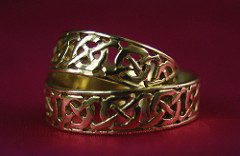A Brief History of Irish Marriage
 Your Irish ancestors might have had a public ceremony that was similar to what many people have today. It probably took place in a church. Or, they might have had a clandestine ceremony without involving the church at all. The history of marriage in Ireland shows that not everyone got married the same way.
Your Irish ancestors might have had a public ceremony that was similar to what many people have today. It probably took place in a church. Or, they might have had a clandestine ceremony without involving the church at all. The history of marriage in Ireland shows that not everyone got married the same way.
In the twelfth and thirteenth centuries, church law on marriage was defined and clarified. These laws determined what constituted a marriage. One important component was consent. The matrimonial bond was created by the freely given consent of the two people who were getting married.
Ideally, the Church preferred that people got married in a public ceremony rather than a private one. The consent of the two people who wanted to get married to each other was of primary importance. It was the consent that made a marriage. The Church recognized marriages that took place in a church as well as those that did not.
There were rules about who was allowed to get married. A person who had been married before, and whose spouse was still living, could not enter into a second marriage. People could not marry someone whom they were closely related to. Those who took holy orders were forbidden from getting married. Each person had to reach puberty before he or she could get married. This worked out to fourteen years of age for boys and twelve years of age for girls.
Irish couples who got married between 1623 and 1866 could have gotten married by license rather than by a bann. (A bann was an official proclamation made by a church that two people had gotten married). Marriage licenses were granted on payment of a fee. The fee either went to the ecclesiastical courts of the Church of Ireland.
By the seventeenth century, marriage was very well defined. People who owned property followed a series of steps that led to an official marriage. The first step was a written legal contract between the two people who wanted to get married. It was about financial arrangements between the bride and groom and their families. This was likely done to secure rights to property and inheritance.
After the finances were worked out, the second step was a formal exchange of vows before witnesses. Next, there would be a public proclamation of the marriage (either by marriage bann or marriage bond). The fourth step was the wedding ceremony itself that took place in a church.
The last step, of course, was consummation of the marriage. It was expected that a married couple would produce children that they would raise together.
Image by anthony kelly on Flickr
Related Articles at FamilyTree.com:
* Research Irish Genealogy at Library of Congress
* Those Maiden Names Of Our Female Ancestors
* The History of the Wedding Dress
< Return To Blog
Leave a Reply